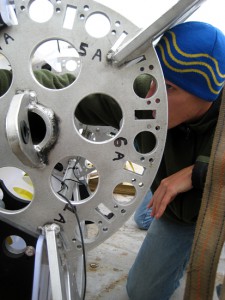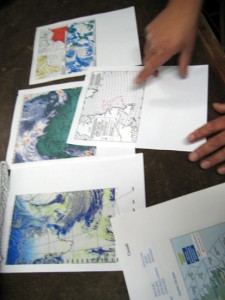
WHOI graduate studant Dave Sutherland loads a float into a SALP rosette. (Photo by Donovan Hohn, Woods Hole Oceanographic Institution)

Mark Maloof delivers a weather report. In the forecast: a low pressure system, storm, 40 knot winds. The conditions are not favorable, but they may get worse. Captain Sheasley, Will Ostrom, and Amy Bower decide not to wait. The mooring deployment will begin as soon as the Knorr reaches the site, at around 9 p.m. tonight. (Photo by Donovan Hohn, Woods Hole Oceanographic Institution)
An Exciting Night at Sea
Wind from the North at 31.5 knots
Ocean depth: is over 3200 meters
Miles from home: over 1200 miles
Today's Audio Postcard (mp3 format)
» Racing against the weather to deploy the mooring
Today's Journal from Kate
It is dark, stormy, and rainy! But the forecast says conditions might worsen. We are at the location to deploy Amy’s instruments to detect and track eddies, so the decision is made by the team to stay up all night to do just that!
We assemble on the deck, everyone with a job to do. The crane operator is seated in his cage high above us, ready to move heavy pieces of equipment into position. The winch operator goes to his post. He controls the meters and meters of wire as the attached instrument move one by one into the sea. Other people are ready with ropes and pulleys to position heavy equipment and to keep it from rolling off the deck.My job is to check off each piece of equipment that is attached to the wire. I need to write down the number of each piece of equipment and assure that it is added to the wire in the correct order. Then I record the time that each piece went over the side of the ship into the water.
The 3200 meters of wire is rolled on a large spool in the center of the stern of the ship. Every piece of equipment, both large and small will be attached to this wire then sent into the sea in one continuous line. The workers on deck, led by engineer Will Ostrom, join the wire to a very large yellow sphere, about 10 feet in diameter.
This buoy will float just below the surface marking the location of the mooring site.
The crane operator lifts the sphere, with workers steadying it by ropes on either side, and it moves slowly into position. Suddenly, it is over the end of the ship, and splashes loudly into the water. The winch operator lets out the wire and the sphere trails behind us.
Quickly, runners bring equipment from inside the lab to the workers who fasten these meters to the wire. The wire continues to trail out behind the ship, meter after meter, for hours. Now it is time for the SALPS, containing the floats designed to track eddies, to be added to the wire. The tension rises! The crane lifts the first none into place. Workers struggle to keep it from rolling away. Here comes the next one! It is rolling too! Everyone holds the ropes and lashes them to metal cleats on the deck. The two SALPS are fastened together. The computers will need to talk to one another so this part is very important.They are expertly joined and soon they are part of the long line of wire trailing behind the ship. In the darkness and rain I cannot see them, but I know they are there.
More wire is sent out with many glass balls attached to help keep the mooring wire afloat in the sea depths. Each glass ball is smaller than the sphere, maybe 3 feet across, and covered by what looks like a pair of yellow hard hats. As we near the end of the wire on the spool, it is time to attach two release mechanisms. Two years from now a sound signal will tell these computers to release the wire from the anchor and set the mooring adrift so that the equipment can be retrieved. Now it is time to attach the anchor!
The anchor weighs more than two tons! It is carefully fastened to the wire. The crane operator lifts it up preparing to swing it over the side of the ship and send it on its way to its precise location on the bottom 3200 meters below.Wait! The line is tangled! Once the line is cleared, the anchor is lifted as the ship slowly turns. The line to the mooring is now aligned with the anchor. Anchor away!
From the computer screen, I record the longitude, latitude and depth on the chart in my hand. The long night is over. However, there is still more data to record and study! As I head for my room, tired, wet and cold at 5 AM, Amy sits down at her computer.

